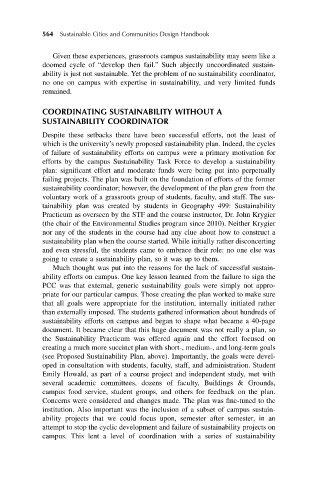Page 597 - Sustainable Cities and Communities Design Handbook
P. 597
564 Sustainable Cities and Communities Design Handbook
Given these experiences, grassroots campus sustainability may seem like a
doomed cycle of “develop then fail.” Such abjectly uncoordinated sustain-
ability is just not sustainable. Yet the problem of no sustainability coordinator,
no one on campus with expertise in sustainability, and very limited funds
remained.
COORDINATING SUSTAINABILITY WITHOUT A
SUSTAINABILITY COORDINATOR
Despite these setbacks there have been successful efforts, not the least of
which is the university’s newly proposed sustainability plan. Indeed, the cycles
of failure of sustainability efforts on campus were a primary motivation for
efforts by the campus Sustainability Task Force to develop a sustainability
plan: significant effort and moderate funds were being put into perpetually
failing projects. The plan was built on the foundation of efforts of the former
sustainability coordinator; however, the development of the plan grew from the
voluntary work of a grassroots group of students, faculty, and staff. The sus-
tainability plan was created by students in Geography 499: Sustainability
Practicum as overseen by the STF and the course instructor, Dr. John Krygier
(the chair of the Environmental Studies program since 2010). Neither Krygier
nor any of the students in the course had any clue about how to construct a
sustainability plan when the course started. While initially rather disconcerting
and even stressful, the students came to embrace their role: no one else was
going to create a sustainability plan, so it was up to them.
Much thought was put into the reasons for the lack of successful sustain-
ability efforts on campus. One key lesson learned from the failure to sign the
PCC was that external, generic sustainability goals were simply not appro-
priate for our particular campus. Those creating the plan worked to make sure
that all goals were appropriate for the institution, internally initiated rather
than externally imposed. The students gathered information about hundreds of
sustainability efforts on campus and began to shape what became a 40-page
document. It became clear that this huge document was not really a plan, so
the Sustainability Practicum was offered again and the effort focused on
creating a much more succinct plan with short-, medium-, and long-term goals
(see Proposed Sustainability Plan, above). Importantly, the goals were devel-
oped in consultation with students, faculty, staff, and administration. Student
Emily Howald, as part of a course project and independent study, met with
several academic committees, dozens of faculty, Buildings & Grounds,
campus food service, student groups, and others for feedback on the plan.
Concerns were considered and changes made. The plan was fine-tuned to the
institution. Also important was the inclusion of a subset of campus sustain-
ability projects that we could focus upon, semester after semester, in an
attempt to stop the cyclic development and failure of sustainability projects on
campus. This lent a level of coordination with a series of sustainability

